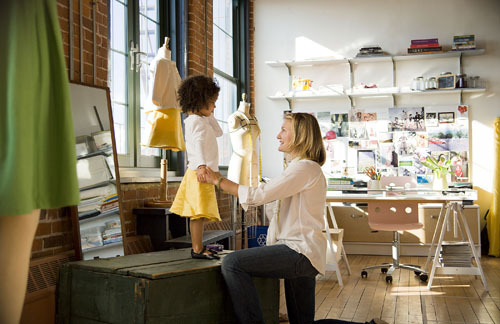
From mattresses to food, parents are willing to spend money on the safest and the healthiest products for their children. And organic in any industry costs more, especially since the highest quality comes from the United States and not from cheaper markets overseas.
Children’s-wear designer Sarah Waldo could have used an overseas factory but felt she would not know for sure the clothes were organic and that the fabrics were chemical-free. “I need to be more involved than that would allow,” said Waldo, whose self-titled clothing line is all organic and geared towards young girls.
Waldo uses a factory based in Fall River. “Knowing I can get to the factory in 20 minutes for any problems or questions is a personal peace of mind,” said Waldo, “not a personal economic benefit.”
There’s also a significant benefit to the environment. Waldo is among the growing number of eco-fashion designers pushing the market to the extreme, a market that doesn’t strain the land with chemicals, over-processing, factory bleaches or pesticides.
Among the chemicals used in fabric production worldwide, “metals that are necessary to make dye stick to clothing have been proven to be toxic,” she said.
Children are generally more susceptible to toxicity levels than adults. Perhaps for this reason, the boom in eco-fashion and organic clothing has begun with the baby market.
“It’s a niche sector,” said Waldo, “parents want to buy healthy things for their newborn and baby clothes don’t demand a huge array of fabrics, styles or prints.”
Taking the organic-clothing movement beyond baby styles, Waldo initiated one of the first such clothing lines for girls up to 14 years of age.
“It was especially difficult to find organic fabrics that are fun, comfortable, colorful and printed,” she said.
The dying and printing methods for organic clothing are strict and expensive, but in the past year the options quadrupled. “Texas is one of the largest organic cotton producers in the world and the demand is now larger than they can produce,” said Waldo.
When asked to comment on the assumptions consumers make about organic clothing, Waldo says with a smile, “beige, draw-string pants.” To push the idea of organic clothing beyond this perception, Waldo wanted to create a line for children that would set new standards in the children’s-wear industry using organic materials.
“It had to be stylish,” she said, “like a European children’s line; challenging to myself to make beautiful.” She uses organic and natural fibers such as cotton, silk, hemp and wool, with low-impact dyes, recycled metal zippers and sustainable findings—such as buttons of nut or shell.
She designs and creates clothes she calls “three-sibling wear” – something you can pass down or share, that will maintain fabric integrity and won’t fray after a few washes. From $28 to $185, the clothing is within a price range parents can support, especially if the clothing lasts.
Boutiques and children’s-wear stores are beginning to notice her line, an accomplishment for any designer. For the first collection out of the Sarah Waldo design studio, she has contracts with stores in Rhode Island, Massachusetts, Maine, and New Hampshire, as well as two stores in California. “The line hits both the organic and Made-in-the-USA markets,” she said.
Waldo describes her line as soft and stylish, cool and appropriate. At the photo-shoot for her first spring collection the models’ ages ranged from 3 to 14. As the day progressed, clothes were modeled and photographs were taken and the young girls ended up squealing over the outfits and begging their parents to buy them.
“They got excited by the clothes,” said Waldo, “but they don’t necessarily understand the concept of organic.” For the kids, the outfits were just clothes they wanted to wear. “That’s all they really need to know,” said Waldo. •











